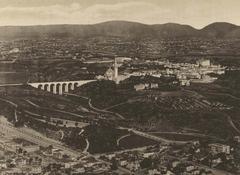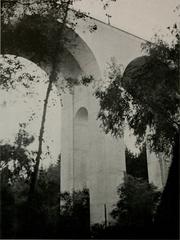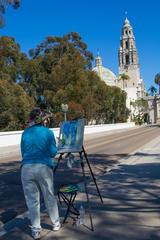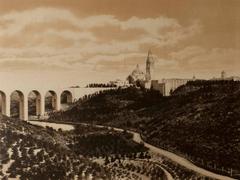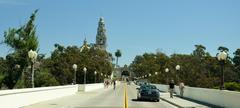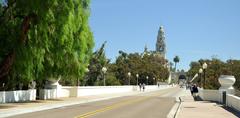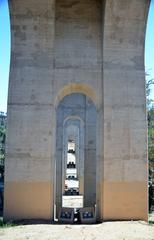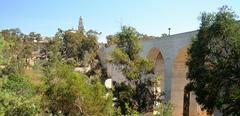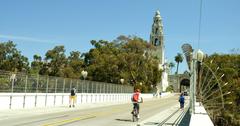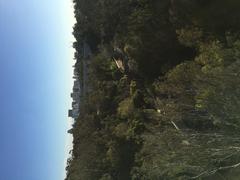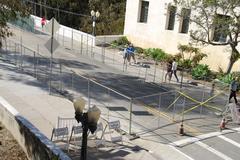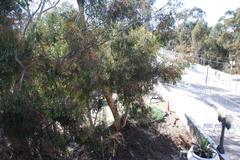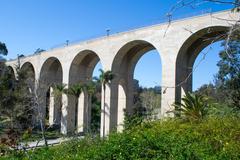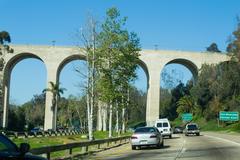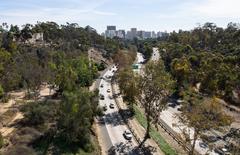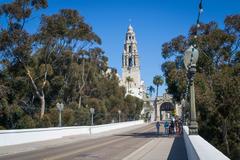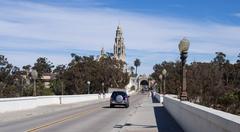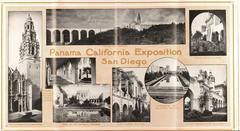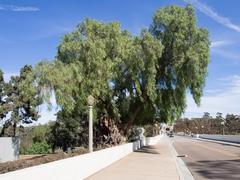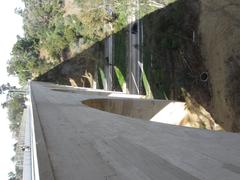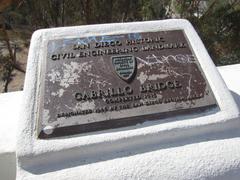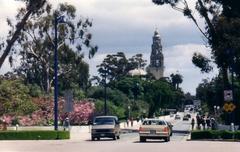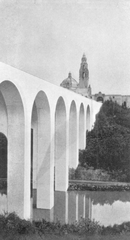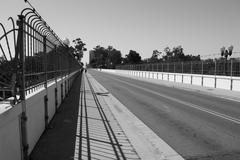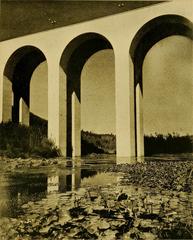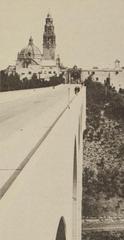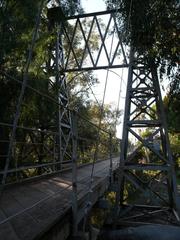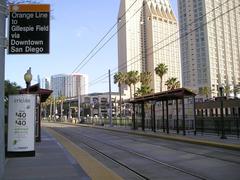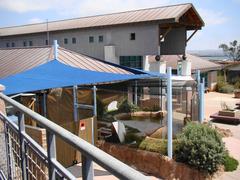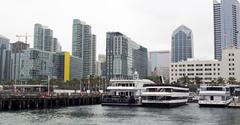
Visiting Cabrillo Bridge: Hours, Tickets, and Travel Tips
Date: 19/07/2024
Exploring the Historical Significance and Visitor Information
The Cabrillo Bridge, also known as the Laurel Street Bridge, is an iconic structure located in San Diego, California. Constructed in the early 20th century, this architectural marvel not only serves as a vital transportation link but also stands as a testament to the city’s rich cultural and historical heritage. The bridge was built as part of the 1915 Panama-California Exposition, an event that marked the opening of the Panama Canal and highlighted San Diego as a significant port city. Designed by architect Frank P. Allen, Jr., the Cabrillo Bridge is a prime example of the Mission Revival and Spanish Colonial Revival architectural styles, characterized by its stucco walls, red-tiled roofs, and ornamental details (San Diego History Center).
Spanning 450 feet across the Cabrillo Canyon and standing 120 feet above the canyon floor, the bridge is supported by seven arches, each with a span of 56 feet. Its construction involved the innovative use of reinforced concrete, making it both strong and aesthetically pleasing. Over the years, it has undergone several renovations and restorations to preserve its structural integrity and historical significance. The bridge has been recognized through various historical designations, including its listing on the National Register of Historic Places as part of the Balboa Park Historic District in 1976 (Balboa Park website).
Today, the Cabrillo Bridge continues to be a vital part of San Diego’s infrastructure and cultural landscape, attracting thousands of visitors annually. Whether you are a history enthusiast, an architecture aficionado, or simply looking for a scenic spot to visit, Cabrillo Bridge offers something for everyone. This comprehensive guide provides detailed information on the bridge’s history, architectural significance, visitor information, and nearby attractions, ensuring you make the most of your visit.
Table of Contents
- Introduction
- Early Conception and Construction
- Architectural Significance
- Role in the Panama-California Exposition
- Post-Exposition Era
- Historical Designations and Preservation Efforts
- Cultural Impact and Legacy
- Modern-Day Relevance
- Visitor Information
- Special Events and Guided Tours
- Conclusion
- FAQs
Exploring Cabrillo Bridge - History, Visiting Hours, Tickets, and More
Introduction
The Cabrillo Bridge, also known as the Laurel Street Bridge, is an iconic structure in San Diego, California. Built in the early 20th century, it has become a symbol of the city’s rich cultural heritage. This article will delve into the bridge’s history, architectural significance, role in the Panama-California Exposition, and provide practical information for visitors, including visiting hours, ticket prices, and travel tips.
Early Conception and Construction
The Cabrillo Bridge’s history dates back to the early 20th century, specifically the planning stages of the 1915 Panama-California Exposition. The exposition was organized to celebrate the opening of the Panama Canal and to promote San Diego as the first U.S. port of call for ships traveling north after passing through the canal.
The bridge was designed by architect Frank P. Allen, Jr., who was also the Director of Works for the exposition. The design was inspired by the Puente de Alcántara in Spain, reflecting the Spanish Colonial Revival style that was prevalent in the architecture of the exposition. Construction began in December 1912 and was completed in April 1914, just in time for the exposition’s opening in January 1915.
Architectural Significance
The Cabrillo Bridge is a marvel of early 20th-century engineering. It spans 450 feet across the Cabrillo Canyon and stands 120 feet above the canyon floor. The bridge is supported by seven arches, each with a span of 56 feet. The use of reinforced concrete was innovative at the time, allowing for the creation of a structure that was both strong and aesthetically pleasing.
The bridge’s design includes elements of the Mission Revival and Spanish Colonial Revival styles, which were popular in California during the early 1900s. These architectural styles are characterized by their stucco walls, red-tiled roofs, and ornamental details, all of which can be seen in the design of the Cabrillo Bridge.
Role in the Panama-California Exposition
The Cabrillo Bridge played a crucial role in the success of the Panama-California Exposition. It served as the main entrance to Balboa Park, where the exposition was held. The bridge provided a grand and dramatic approach to the park, setting the tone for the architectural splendor that visitors would encounter within.
During the exposition, the bridge was adorned with decorative lighting and banners, enhancing its visual impact. It quickly became one of the most photographed landmarks of the event. The exposition itself was a significant milestone for San Diego, attracting millions of visitors and putting the city on the map as a major cultural and economic center.
Post-Exposition Era
After the exposition, the Cabrillo Bridge continued to serve as a vital transportation link, connecting the western part of San Diego with Balboa Park and the eastern neighborhoods. Over the years, the bridge has undergone several renovations and restorations to preserve its structural integrity and historical significance.
In the 1930s, the bridge was widened to accommodate increasing traffic. This involved adding sidewalks and railings, which were designed to blend seamlessly with the original architectural style. In the 1960s, the bridge was closed to vehicular traffic for a period due to concerns about its structural stability. It was subsequently reinforced and reopened.
Historical Designations and Preservation Efforts
The Cabrillo Bridge has been recognized for its historical and architectural significance through various designations. In 1976, it was listed on the National Register of Historic Places as part of the Balboa Park Historic District. This designation helps ensure that any alterations or renovations to the bridge are carried out in a manner that preserves its historical integrity.
In recent years, there have been ongoing efforts to maintain and preserve the bridge. In 2014, a major restoration project was undertaken to repair and reinforce the bridge’s concrete structure, address drainage issues, and restore its decorative elements. This project was completed in time for the centennial celebration of the Panama-California Exposition in 2015.
Cultural Impact and Legacy
The Cabrillo Bridge is more than just a transportation link; it is a cultural icon and a symbol of San Diego’s rich history. It has been featured in numerous films, television shows, and photographs, further cementing its status as a beloved landmark. The bridge’s graceful arches and scenic views make it a popular spot for both locals and tourists.
The bridge also plays a significant role in the cultural life of San Diego. It serves as a gateway to Balboa Park, which is home to numerous museums, gardens, and cultural institutions. Events such as the annual December Nights festival and various parades often incorporate the bridge, highlighting its importance as a community gathering place.
Modern-Day Relevance
Today, the Cabrillo Bridge continues to be a vital part of San Diego’s infrastructure and cultural landscape. It remains open to pedestrian and vehicular traffic, providing a scenic route into Balboa Park. The bridge’s historical significance and architectural beauty make it a must-see destination for visitors to San Diego.
Visitor Information
Visiting Hours: The Cabrillo Bridge is accessible to pedestrians and vehicles 24/7. However, if you plan to visit Balboa Park, it is advisable to check specific opening hours for the park’s attractions.
Ticket Prices: There is no admission fee to walk or drive across the Cabrillo Bridge. However, individual attractions within Balboa Park may have their own entry fees.
Travel Tips: The bridge is located near several parking lots within Balboa Park, making it convenient for visitors. Public transportation options, including buses and trolleys, also serve the area.
Nearby Attractions: Balboa Park itself is a treasure trove of attractions, including the San Diego Zoo, multiple museums, gardens, and theaters. Plan to spend a full day exploring the park’s offerings.
Accessibility: The Cabrillo Bridge is wheelchair accessible, and Balboa Park offers various services to assist visitors with disabilities.
Special Events and Guided Tours
Throughout the year, the Cabrillo Bridge and Balboa Park host numerous events, including festivals, parades, and guided tours. These events often highlight the historical and cultural significance of the bridge and the park. Check the Balboa Park website for a calendar of upcoming events.
Conclusion
The Cabrillo Bridge stands as a testament to the vision and ingenuity of its creators and serves as a reminder of San Diego’s rich cultural heritage. Whether you are a history enthusiast, an architecture aficionado, or simply looking for a scenic spot to visit, the Cabrillo Bridge offers something for everyone. Be sure to explore this historic landmark and the surrounding Balboa Park to fully appreciate its significance.
For more detailed information on the history and significance of the Cabrillo Bridge, you can visit the San Diego History Center.
FAQs
Q: What are the visiting hours for Cabrillo Bridge?
A: The bridge is accessible 24/7, but specific attractions within Balboa Park have their own hours.
Q: Is there an admission fee to visit the Cabrillo Bridge?
A: No, there is no fee to walk or drive across the bridge.
Q: Are there guided tours available?
A: Yes, Balboa Park offers guided tours that include the Cabrillo Bridge. Check their website for schedules.
Q: What are some nearby attractions?
A: Nearby attractions include the San Diego Zoo, multiple museums, gardens, and theaters within Balboa Park.
Stay Up to Date
For the latest updates and to explore more about San Diego’s rich history, download our mobile app Audiala, check out other related posts, and follow us on social media.
Summary and Key Takeaways
In conclusion, Cabrillo Bridge is more than just a transportation link; it is a cultural icon and a symbol of San Diego’s rich history and architectural ingenuity. From its early conception and construction for the 1915 Panama-California Exposition to its ongoing role as a gateway to Balboa Park, the bridge has played a crucial part in shaping the city’s identity. Its architectural significance, characterized by the Mission Revival and Spanish Colonial Revival styles, and the use of innovative construction techniques, make it a marvel of early 20th-century engineering (San Diego History Center).
The bridge’s cultural impact is evident in its role as a popular spot for locals and tourists alike, and its historical significance is preserved through various designations and continuous restoration efforts. Visitors can enjoy stunning views, participate in guided tours, and explore nearby attractions such as the San Diego Zoo, multiple museums, gardens, and theaters within Balboa Park (Balboa Park website).
As a must-visit landmark in San Diego, Cabrillo Bridge offers a unique blend of historical, architectural, and cultural experiences. Whether you are visiting for the first time or returning to enjoy its timeless beauty, Cabrillo Bridge stands as a testament to the vision and ingenuity of its creators and continues to be a cherished landmark for future generations. For more tips and updates, download the mobile app Audiala, check out other related posts, or follow us on social media.
References
- Exploring Cabrillo Bridge - History, Visiting Hours, Tickets, and More, 2024, Unknown Author (San Diego History Center)
- Cabrillo Bridge - Historical Significance, Visiting Hours, and Travel Tips, 2024, Unknown Author (Balboa Park website)
- Complete Visitor Guide to Cabrillo Bridge, San Diego - Tips, Tickets, and More, 2024, Unknown Author (Balboa Park website)

